PHOTOGRAPHER Jill Mead was cycling along the Grand Union Canal near Paddington in 2018 when she saw something wonderful.
A mural of red and blue paint extending across the back wall of about eight houses, with random ceramic tiles and beautiful glass doorknobs mounted on the wall, and all along it a line of thigh-high sculptures standing to attention, behind two rows of immaculately pruned fir trees.
From her position across the canal she saw an elderly gentleman over the top of that wall. She waved to him, raised her camera and snapped a picture.
It took Jill two years but feeling compelled to return, she arrived at Gerard Dalton’s flat on Hormead Road in July earlier this year.
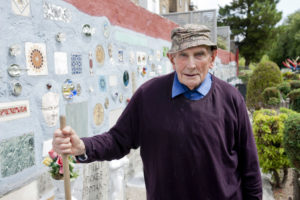 Gerry pictured in his art-filled garden, prior to his death this year (Pic: Jill Mead)
Gerry pictured in his art-filled garden, prior to his death this year (Pic: Jill Mead)Gerard, or ‘Gerry’ to those who knew him, was an Irishman from Killinure, just outside Galsson in Co. Westmeath.
Born to small farmers in 1935, he was educated at Cistercian boarding school in Roscrea College.
Gerry was to finish his formal education at age fourteen due to poor health - suffering from asthma his whole life - but he would continue reading books and always had a great love for history. He returned to work on the family farm and according to his family, he had every hedge clipped to perfection around the family plot.
Gerry emigrated to London when he was 24 years old and worked various jobs as a railway porter and a kitchen worker until his retirement, aged 60.
He was inspired by all the places he saw when he moved to London in the late fifties and got the idea of statues when he first went to museums. It wasn’t until after his retirement, in 1996, that Gerry made his first statue: Leo Casey, the Irish poet.
He had no artistic training, he just figured it out on his own, creating statues out of concrete of people he thought were most notable in history; Charles II, Lord Nelson, Robert Emmett, Christopher Wren, the Irish warrior-queen Maeve, Anne Boleyn, Oliver Goldsmith, Prince Albert, the Duke of Wellington - about 200 statues in total, a regiment of quirky, historical figures.
 Gerry's ornate pieces of art can be found inside and outside his London flat (Pic: Jill Mead)
Gerry's ornate pieces of art can be found inside and outside his London flat (Pic: Jill Mead)His creativity took over his flat too, as he made scale models of palaces and historical buildings that filled every room. His bed was in the midst of Windsor Castle and Buckingham Palace, he had Westminster Abbey in the bathroom, and a Brutalist tower next to his kitchen sink.
The day Jill Mead came to visit, she was astonished to find far more than she had seen from across the canal two years before. Gerard welcomed her into his kitchen and garden where she saw the full collection of statues he once called ‘Gerry’s pompeii’.
It left a lasting impression on Jill, who was very touched by the experience and could not believe he wasn’t a household name. She felt she was in the presence of a sort-of humble, creative genius. “They are a bit like modern art,” said Jill. “Totally unique, quirky, endearing.”
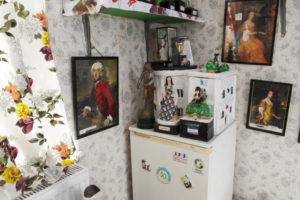 When photographer Jill Mead met Irishman Gerry, she found the decor inside his flat was as quirky as that in his garden
When photographer Jill Mead met Irishman Gerry, she found the decor inside his flat was as quirky as that in his gardenThey talked for a few hours and she took pictures of Gerry in his garden, hat on, leaning on his broom. She left with a present from Gerry - a porcelain figurine of a fruit picker and a Roy Rogers western film on DVD, ‘In Old Caliente’.
A few weeks after they met, Gerry passed away, aged 83, leaving behind his vast collection of artwork. The question now was, what would happen to it?
Speaking to his nephew John Elliott, years before, Gerry had asked, ‘When I’m gone, you’ll look after them, won’t you?’
The Elliotts were the only family he had: his nephew and niece, John and Marilyn, and his younger sister Kitty and her husband. They lived in Perivale, just a few miles further west along the canal and Gerry would sometimes walk the whole way there to visit them - always on a Friday - bringing a packet of Rolos each for John and Marilyn.
“I think he had a lot of affection for me and my sister Marilyn,” John told The Irish Post.
“You’d see in the glint of his eye, he really enjoyed watching us growing up.”
“He was a really gentle kind of person, he didn’t bother anybody. He just did his own thing.”
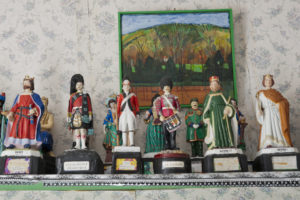 More of Gerry's self-made trinkets (Pic: Jill Mead)
More of Gerry's self-made trinkets (Pic: Jill Mead)He was a man of few words and his family had no idea that those who knew him had such great affection for him. “We’re really bowled over by the love that his neighbours have for him,” said John.
Despite the effort he put into creating it, Gerard didn’t own his flat and now the ‘site-specific’ artwork is under threat from Notting Hill Genesis, the social housing association, who want to repossess and empty the property.
It is a conflict between the need for social housing, and the effort to preserve the unique site. The locals battling to save it have been told they would need to raise £550,000 pounds to buy the site before the eviction date.
Led by freelance curator Sasha Galitzine, the campaign to save ‘Gerry’s Pompeii’ has gained the support of some leading names in the art world. A letter of appeal asking for more time to fundraise the ambitious amount was sent to the CEO of Notting Hill Genesis housing association last week, signed by the Director of the V&A Dr Tristram Hunt, Pulp frontman Jarvis Cocker and many others.
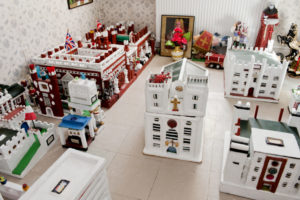 A campaign has been launched to save 'Gerry's Pompeii' (Pic: Jill Mead)
A campaign has been launched to save 'Gerry's Pompeii' (Pic: Jill Mead)Ideally the campaigners would like a benefactor to step in to buy the site, which would then be preserved as something like an open house for visitors.
When contacted by The Irish Post a Notting Hill Genesis spokesperson said: “Gerry’s death was very sad, but his memory lives on in the inspiring and extraordinary artwork he has left for his family and friends.
“We are giving as much support as we can to protect his legacy and encourage his friends, as well as art lovers who have so admired his work, to ensure it is looked after and available for people to see and appreciate in the future. But we are a housing association and our priority has to be providing a home to people who need one. Gerry’s former home is in an area of huge housing demand and we must enable others to enjoy the safety and security of social housing.
“We extended our original deadline to give Gerry’s friends and supporters as much time as possible to identify a solution. As that hasn’t proved possible, we now need to find the best way to ensure that we can offer the home to a new tenant and that Gerry’s collection is looked after somewhere else.
“We will continue to speak to Gerry’s family and the wider community over the future of this amazing collection.”
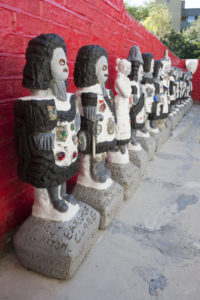 Gerry's soldiers stand to attention at his London flat - but for how much longer?
Gerry's soldiers stand to attention at his London flat - but for how much longer?Since his death, Gerard Dalton, the unlikely artist, has attracted the attention of not only rockstars but historians and professors alike.
British cultural historian and former Director of the National Portrait Gallery, Sir Charles Saumarez Smith CBE, has described it as ‘a folk version of the National Portrait Gallery’.
Oxford Professor Dan Hicks, Curator and Professor of Contemporary Archaeology, described the unique landscape as “a kind of Po-Mo Rococo” - Rococo being a Late Baroque architectural style.
What Gerry would make of all this, we can only guess. His ashes rest in Tubberclair Church back in his native Ireland and in London, on the statue he made of himself that overlooks the canal, he has simply inscribed the humble words ‘Gerry the gardener’.
For further information or to support the campaign click here.

